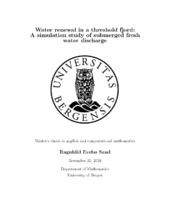Water renewal in a threshold fjord: A simulation study of submerged fresh water discharge
Master thesis
Permanent lenke
https://hdl.handle.net/1956/18846Utgivelsesdato
2018-12-15Metadata
Vis full innførselSamlinger
Sammendrag
Threshold fjords are characterized by low concentrations of oxygen in the depths of the basin, caused by weak and/or infrequent exchange of the basin water. A three-dimensional ocean model, The Bergen Ocean Model (BOM), has been used to estimate effects of a submerged fresh water discharge in a threshold fjord. The principle of discharging fresh water at a depth and thus creating artificial upwelling is known to give promising results for the primary production. The aim of this study was to examine if a discharge at the bottom of the basin could increase the ventilation and/or circulation of the basin water. Three preliminary experiments and four main experiments were performed and the results indicated an effect of such discharges. Both the circulation and ventilation of the basin water was increased by the intervention of a submerged discharge. The main effect was a reduction in the density of the basin water, as the dense bottom water was mixed with the discharge and elevated due to buoyancy. This lead to high density intrusion of coastal water along the sill. In the four main experiments, the area and the flux of the discharge were adjusted. These adjustments indicated that a greater discharge area or a higher flux lead to more entrainment of the dense bottom water.
